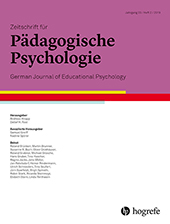Assessment of Competences in Sustainability Management: Analyses to the Construct Dimensionality
Abstract
Abstract. The paper discusses an examination of the dimensions of a competence model for sustainability management. A central assumption is that the dimensions of the competence model differ according to knowledge representation (i. e., declarative vs. schematic and strategic knowledge) and content area (i. e., business administration and sustainability from a societal perspective, as well as sustainability management). Study participants included 850 students from 16 universities in Germany, and the analyses were conducted on the basis of structural equation modeling. The results reveal an expectation-compliant finding whereby the types of knowledge addressed by different assessment formats and content requirements can be presented in two disjunct dimensions. On the one hand, the model analyses indicate a better fit to the multidimensional model, which distinguishes between declarative knowledge in the field of business administration and sustainability from a social perspective, while on the other hand, the analyses suggest a better fit to sustainability management.
Zusammenfassung. Dieser Beitrag thematisiert die Messung von Kompetenzen für das Nachhaltigkeitsmanagement. Eine zentrale Annahme des zugrunde gelegten Kompetenzmodells ist, dass sich die Dimensionen nach der Wissensrepräsentation (deklaratives vs. schematisches und strategisches Wissen) und nach inhaltlichen Bereichen (Betriebswirtschaft, Nachhaltigkeit aus gesellschaftlicher Perspektive und Nachhaltigkeitsmanagement) unterscheiden. An der Studie nahmen 850 Studierende aus 16 deutschen Universitäten wirtschaftswissenschaftlicher Studiengänge teil. Die Analysen wurden auf der Grundlage von Strukturgleichungsmodellierungen durchgeführt. Die Ergebnisse zeigen einen erwartungskonformen Befund dahingehend, dass die über unterschiedliche Assessmentformate und inhaltliche Anforderungen adressierten Wissensarten zwei disjunkte Dimensionen darstellen. Die Modellanalysen zeigen eine bessere Passung zum mehrdimensionalen Modell, bei dem zwischen deklarativem Wissen im Bereich der Betriebswirtschaftslehre und der Nachhaltigkeit aus gesellschaftlicher Perspektive einerseits und dem Nachhaltigkeitsmanagement andererseits unterschieden wird.
References
(2014). Emerging areas in research on higher education for sustainable development – management education, sustainable consumption and perspectives from Central and Eastern Europe. Journal of Cleaner Production, 62 (1), 1 – 7.
(2001). A Taxonomy for Learning, Teaching, and Assessing. A Revision of Bloom's Taxonomy of Educational Objectives. New York: Longman.
(2015): Routledge handbook of higher education for sustainable development. New York: Routledge.
(2008):
Gestaltungskompetenz als Kompetenzkonzept der Bildung für eine Nachhaltige Entwicklung . In I. BormanG. de Haan (Eds.), Kompetenzen der Bildung für nachhaltige Entwicklung (pp. 23 – 43). Wiesbaden: VS.(1999). Triple bottom-line reporting: Looking for balance. Australian CPA, 69 (2), 18 – 21.
ETS: Educational Testing Service . (2011). Find out how to prove – and improve – the effectiveness of your Business program with the ETS® Major Field Tests. Available from: http://www.ets.org/Media/Tests/MFT/pdf/mft_testdesc_business_4cmf.pdf(2014). Educating Change Agents for Sustainability–learnings from the first Sustainability Management Master of Business Administration. Journal of Cleaner Production, 62 (1), 24 – 36.
& (1999) . Cutoff criteria for fit indexes in covariance structure analysis. Conventional criteria versus new alternatives Structural Equation Modeling, 6 (1), 1 – 55.
(2002). To Parcel or Not to Parcel. Exploring the Question, Weighing the Merits. Structural Equation Modeling, 9 (2), 151 – 173.
Michaelis C. (2017). Kompetenzentwicklung zum nachhaltigen Wirtschaften. Eine Längsschnittstudie in der kaufmännischen Ausbildung. Frankfurt am Main: Peter-Lang.(2011). Indikatoren der Bildung für nachhaltige Entwicklung – Ein Werkstattbericht. Bad Homburg: VAS.
(2011). Sustainable management: coping with the dilemmas of resource-oriented management. Berlin: Springer.
(1998 – 2012). Mplus User’s Guide (7th ed.). Los Angeles, CA: Muthén & Muthén.
R Core Team (2017). R: A language and environment for statistical computing. R Foundation for Statistical Computing, Vienna, Austria. Available from: https://www.R-project.org/(2018). TAM: Test analysis modules. R package version 2, 9 – 35. Available from: https://CRAN.R-project.org/package=TAM
(2010). Ensuring Positiveness of the Scaled Difference Chi-square Test Statistic. Psychometrika, 75 (2), 243 – 248.
(2002). The Link between “Green” and Economic Success: Environmental Management as the Crucial Trigger between Environmental and Economic Performance. Journal of Environmental Management, 65 (4), 339 – 346
(2006). Managing the Business Case for Sustainability, Sheffield: Greenleaf.
(2014). Development of a Model of Competencies Required for Sustainable Economic Performance among Apprentices in Business Education. Available in the AERA repository http://www.aera.net/repository
(2016).
Ko-NaMa – Simulation-based Measurement and Validation of a Competence Model for Sustainability Management . In H.A. PantO. Zlatkin-TroitschanskaiaC. LautenbachM. ToepperD. Molerov (Eds.), Modeling and Measuring Competencies in Higher Education – Validation and Methodological Innovations (KoKoHs) – Overview of the Research Projects (KoKoHs Working Papers, 11 ) (pp. 53 – 56). Berlin & Mainz: Humboldt University & Johannes Gutenberg University.(1999).
On the psychometrics of assessing science understanding . In J. J. MintzesJ. H. WamherseeJ. D. Novak (Eds.), Assessing science understanding: Ahuman constructivist view (pp. 303 – 341). New York: Academic Press.(2005). Windows into the mind. Higher education, 49 (4), 413 – 430.
Statistisches Bundesamt (2018). Fachserie 11 Reihe 4.1. Wintersemester 2017 / 18.(2014). Business Administration. Taylor & Francis: London.
World Commission on Environment and Development (WCED) (1987). Our Common Future. Available from: http://www.un-documents.net/wced-ocf.htm(2016). Messung akademisch vermittelter Kompetenzen von Studierenden und Hochschulabsolventen. Ein Überblick zum nationalen und internationalen Forschungsstand. Wiesbaden: Springer VS.



